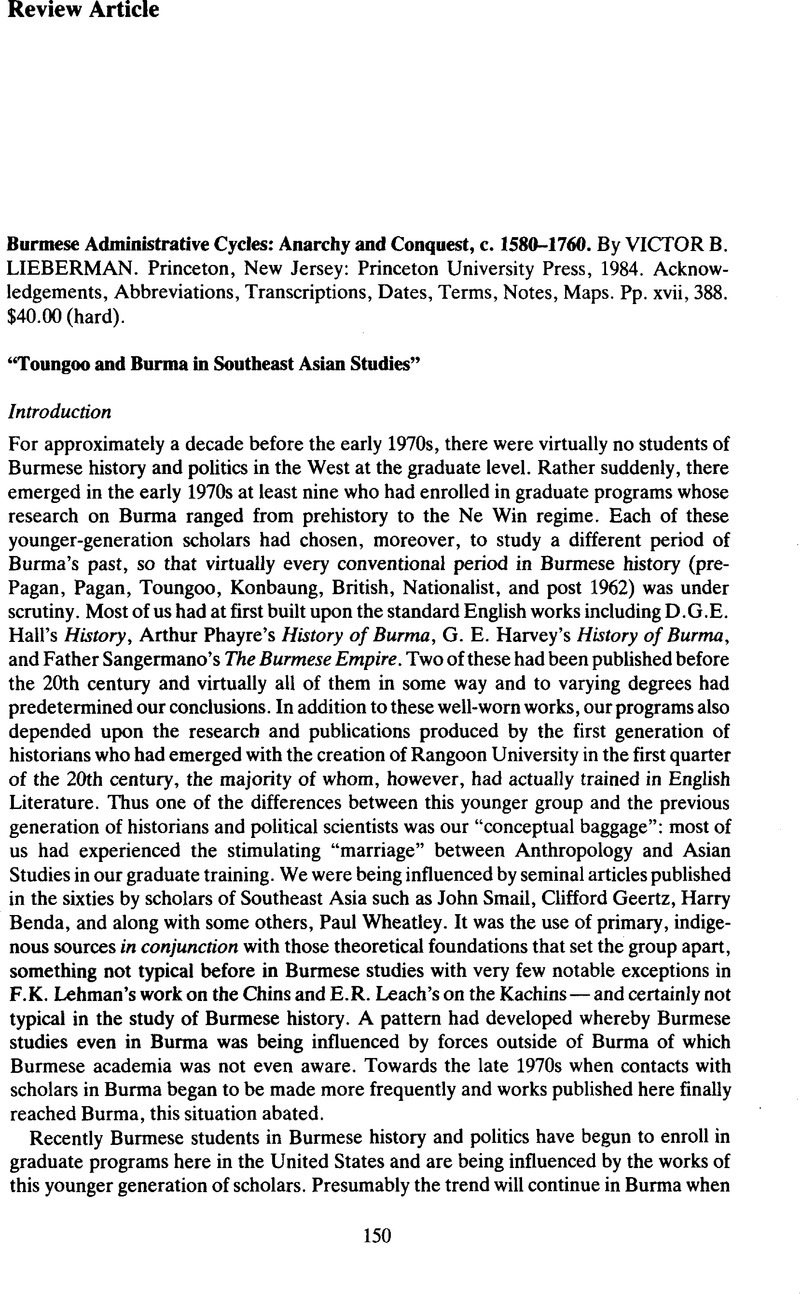Published online by Cambridge University Press: 07 April 2011

1 Rabibhadana, Akin, The Organization of Thai Society in the Early Bangkok Period, 1782–1873 (Ithaca: Cornell University Southeast Asia Program Data paper no. 74, 1970)Google Scholar.
2 Aung-Thwin, Michael, “Kingship, the Sangha, and Society in Pagan”, in Explorations in Early Southeast Asian History: The Origins of Southeast Asian Statecraft, eds. Hall, Kenneth R. and Whitmore, John K (Ann Arbor: Michigan Papers on South and Southeast Asia no. 11, 1976, pp. 205–256;Google Scholar“The Role of Sasana Reform in Burmese History: Economic Dimensions of a Religious Purification”, Journal of Asian Studies 38, 4 (1979): 671–88Google Scholar.
3 Bennett, Paul J., Conference Under the Tamarind Tree: Three Essays in Burmese History (New Haven: Yale University Southeast Asia Studies Monograph Series no. 15, 1971, pp. 57–99)Google Scholar.
4 Adas, Michael, “‘Moral Economy’ or ‘Contest State’?: Élit e Demands and the Origins of Peasant Protest in Southeast Asia”, Journal of Social History 13, 4 (1980): 521–46CrossRefGoogle Scholar.
5 Aung-Thwin, Michael, “Athi, Kyun-Taw, Hpaya-Kyun: Varieties of Commendation and Dependence in Pre-Colonial Burma”, in Slavery, Bondage and Dependency in Southeast Asia, ed. Reid, Anthony (St. Lucia: University of Queensland Press, 1983), pp. 64–89Google Scholar.
6 I agree, and have argued previously, that Burmese history might well be appropriately seen in Vico's concept of history, i.e., a spiral, as in a coiled spring. See Aung-Thwin, Michael, “A Reply to Lieberman”, Journal of Asian Studies 40, no. 1 (11 1980): 87–90CrossRefGoogle Scholar.
7 See p. Ill, n. 158, which cites 20th-century guesses that the maha-dan wun may have been a Toungoo era official. There was virtually an exact equivalent in the 12th century. The same is true of the distinction made between bayin and myo-wun, which may have nothing to do with a new type of official replacing an older one, but simply an “inflation” of titles similar to that which occurred in the word min which went from King in the 11th century to a government official in 20th century Burma. Similarly, on page 121, Lieberman writes that “perhaps the strongest indication of commercial expansion and integration was the gradual substitution of imported silver for copper as the standard medium of exchange” which went on to have further effects and “changes”. Here again, there was nothing new about the use of silver (which the author acknowledged, for we know that in the 12th and 13th century Pagan, silver was the standard medium of exchange and with little or no relationship to commercial expansion.
8 Michael Aung-Thwin, “Burma Before Pagan: The Status of Archaeology Today”, forthcoming in Asian Perspectives.
9 Aung-Thwin, Michael, “Jambudrpa: Classical Burma's Camelot”, Contributions to Asian Studies 16 (1981): 38–61Google Scholar.
10 Wiant, John A., “Tradition in the Service of Revolution: The Political Symbolism of Taw Wan Ye Knit”, in Military Rule in Burma Since 1962: A Kaleidoscope of Views, ed. Lehman, F. K. (Singapore: Maruzen Asia, 1981), p. 4Google Scholar;Chaloemtiarana, Thak, Thailand, the Politics of Despotic Paternalism (Bangkok: Social Science Association of Thailand and Thai Khadi Institute, Thammasat University, 1979)Google Scholar;Aung-Thwin, Michael, “The British Pacification of Burma: Order Without Meaning”, forthcoming in the Journal of Southeast Asian Studies; andGoogle ScholarTaylor's, Robert H. “Perceptions of Ethnicity in the Politics of Burma”, Southeast Asia Journal of Social Science 10, 1 (1982): 7–22CrossRefGoogle Scholar.
11 Tin, U (Pagan Wun-dauk), Myanma Min Okchokpon Sadan, III (Rangoon: Baho Press, 1970) [reprint], p. 55. See also Than Tun's translation ofGoogle ScholarMin's, Badon [Bodawhpaya] edict entitled “The Royal Order (Wednesday, 28 January 1795) of King Badon”, Journal of Asian and African Studies [Tokyo] 26 (1983): 153–201Google Scholar.
12 Lieberman, Victor B., “The Political Significance of Religious Wealth in Burmese History: Some Further Thoughts”, Journal of Asian Studies 39, 4 (1980): 753–69;CrossRefGoogle Scholar Michael Aung-Thwin, “The Role of Sasana Reform” and “A Reply”.
13 Reynolds, Frank E. and Clifford, Regina T., “Sangha, Society and the Struggle for National Integration: Burma and Thailand”, in Transitions and Transformations in the History of Religions, eds.Reynolds, Frank E. and Ludwig, Theodore M. (Leiden: E. J. Brill, 1980), pp. 56–88Google Scholar.
14 Scott, James C., The Moral Economy of the Peasant: Rebellion and Subsistence in Southeast Asia (New Haven: Yale University Press, 1976); Michael AdasGoogle Scholar.